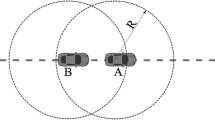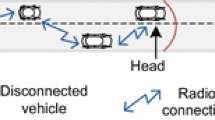Abstract
In this paper, we present analytical models for the probability density function (PDF) of link life time in vehicular ad hoc networks (VANETs), formed on both single lane as well as multi lane highways. Assuming free flow traffic state and Gaussian distributed vehicle speed, we extensively investigate the impact of vehicle mobility, vehicle density and transmission range on the link life time PDF and the mean link life time in VANETs. Our analytical and simulation results suggest that in the free-flow traffic state, exponential distribution with appropriate parametrization is a good approximation for the link life time PDF. We perform the Kolmogorov–Smirnov goodness-of-fit test to ascertain the validity of this claim.













Similar content being viewed by others
References
Bai, F., Sadagopan, N., Krishnamachari, B., & Helmy, A. (2004). Modeling path duration distributions in manets and their impact on reactive routing protocols. IEEE Journal on Selected Areas in Communications, 22(7), 1357–1373.
Barghi, S., Benslimane, A., & Assi, C. (2009). A lifetime-based routing protocol for connecting vanets to the internet. In World of wireless, mobile and multimedia networks & workshops, 2009. WoWMoM 2009. IEEE international symposium (pp. 1–9). IEEE.
Boban, M., Misek, G., & Tonguz, O. (2008). What is the best achievable qos for unicast routing in vanets? In GLOBECOM workshops, 2008 IEEE (pp. 1–10). IEEE.
Boleng, J., Navidi, W., & Camp, T. (2002). Metrics to enable adaptive protocols for mobile ad hoc networks. In Proceedings of the international conference on wireless networks (ICWN02) (pp. 293–298).
Cardote, A., Sargento, S., & Steenkiste, P. (2010). On the connection availability between relay nodes in a vanet. In GLOBECOM workshops (GC Wkshps), 2010 IEEE (pp. 181–185). IEEE.
Gradshteyn, I., & Ryzhik, I. (1994). Table of integrals, series and products. New York: Academic Press,- c1994, 5th ed. completely reset, edited by Jeffrey, Alan 1.
Gruber, I., & Li, H. (2002). Link expiration times in mobile ad hoc networks. In 27th Annual IEEE conference on local computer networks, 2002. Proceedings. LCN 2002 (pp. 743–750). IEEE.
IEEE 802.11p/d5.0. (2008). Draft amendment to standard for information technology telecommunications and information exchange between systems lan/man specific requirements part 11: Wlan medium access control (mac) and physical layer (phy) specifications: wireless access in vehicular environments (wave).
Li, Y., Jin, D., Wang, Z., Zeng, L., & Chen, S. (2013). Exponential and power law distribution of contact duration in urban vehicular ad hoc networks. Signal Processing Letters, IEEE, 20(1), 110–113.
Liu, J., Ren, P., Xue, S., & Chen, H. (2012). Expected path duration maximized routing algorithm in cr-vanets. In IEEE international conference on communication in China (pp. 659–663).
McShane, W. (2004). Traffic engineering (3rd ed.). Pearson Prentice Hall.
Neelakantan, P., & Babu, A. (2013). Connectivity analysis of vehicular ad hoc networks from a physical layer perspective. Journal on Wireless Personal Communications, 71(1), 45–70.
Oliveira, R., Furtadoa, A., Bernardoa, L., Pintoa, P., et al. (2013). Improving path duration in high mobility vehicular ad hoc networks. Journal Ad Hoc Networks, 11(1), 89–103.
Panichpapiboon, S., & Pattara-atikom, W. (2008). Connectivity requirements for self-organizing traffic information systems. IEEE Transactions on Vehicular Technology, 57(6), 3333–3340.
Pascoe-Chalke, M., Gomez, J., Rangel, V., & Lopez-Guerrero, M. (2010). Route duration modeling for mobile ad-hoc networks. Journal on Wireless Networks, 16(3), 743–757.
Rudack, M., Meincke, M., Jobmann, K., & Lott, M. (2003). On traffic dynamical aspects of inter vehicle communications (ivc). In IEEE 58th vehicular technology conference, 2003. VTC 2003-Fall (Vol. 5, pp. 3368–3372). IEEE.
Sofra, N., & Leung, K. (2009). Link classification and residual time estimation through adaptive modeling for vanets. In IEEE 69th vehicular technology conference, 2009. VTC Spring 2009 (pp. 1–5). IEEE.
Sofra, N., Gkelias, A., & Leung, K. (2011). Route construction for long lifetime in vanets. IEEE Transactions on Vehicular Technology, 60(7), 3450–3461.
Sun, W., Yamaguchi, H., Yukimasa, K., & Kusumoto, S. (2006). Gvgrid: A qos routing protocol for vehicular ad hoc networks. In 14th IEEE international workshop on quality of service, 2006. IWQoS 2006 (pp. 130–139). IEEE.
The network simulator ns-2: http://www.isi.edu/nsnam/ns/ns-documentation.html.
Tsao, C., Liao, W., & Kuo, J., et al. (2006). Link duration of the random way point model in mobile ad hoc networks. In Wireless communications and networking conference, 2006. WCNC 2006. IEEE (Vol. 1, pp. 367–371). IEEE.
Wang, S. (2005). The effects of wireless transmission range on path lifetime in vehicle-formed mobile ad hoc networks on highways. In IEEE international conference on communications, 2005. ICC 2005 (Vol. 5, pp. 3177–3181). IEEE.
Wu, J. (2009). Connectivity of mobile linear networks with dynamic node population and delay constraint. IEEE Journal on Selected Areas in Communications, 27(7), 1218–1225.
Wu, Y., Liao, W., Tsao, C., & Lin, T. (2009a). Impact of node mobility on link duration in multihop mobile networks. IEEE Transactions on Vehicular Technology, 58(5), 2435–2442.
Wu, X., Sadjadpour, H., & Garcia-Luna-Aceves, J. (2009b). Link dynamics in manets restricted node mobility: Modeling and applications. IEEE Transactions on Wireless Communications, 8(9), 4508–4517.
Yan, G., & Olariu, S. (2011). A probabilistic analysis of link duration in vehicular ad hoc networks. IEEE Transactions on Intelligent Transportation Systems, 12(4), 1227–1236.
Yousefi, S., Mousavi, M., & Fathy, M. (2006). Vehicular ad hoc networks (vanets): Challenges and perspectives. In ITS telecommunications proceedings, 2006 6th international conference (pp. 761–766). IEEE.
Yousefi, S., Altman, E., El-Azouzi, R., & Fathy, M. (2008). Analytical model for connectivity in vehicular ad hoc networks. IEEE Transactions on Vehicular Technology, 57(6), 3341–3356.
Zeadally, S., Hunt, R., Chen, Y., Irwin, A., & Hassan, A. (2012). Vehicular ad hoc networks (vanets): Status, results, and challenges. Journal on Telecommunication Systems, 50(4), 217–241.
Zhu, H., Fu, L., Xue, G., Zhu, Y., Li, M., & Ni, L. M. (2010). Recognizing exponential inter-contact time in vanets. In INFOCOM, 2010 Proceedings IEEE (pp. 1–5). IEEE.
Author information
Authors and Affiliations
Corresponding author
Appendices
Appendix 1
Since the link life time \(T^{(0)}\) is given by (5), its CDF \(F_{T^{(0)}}(t)\) can be determined as follows:
Using the principle of random variable transformation and by referring to Figs. 14 and 15, \(F_{T^{(0)}}(t)\) can be determined as follows:
The PDF of \(T^{(0)}\), \(f_{T^{(0)}}(t)\) is obtained by differentiating 17 with respect to \(t\) and is given by:
where the components \(f_{T_1^{(0)}}(t)\) and \(f_{T_2^{(0)}}(t)\) correspond to the following two cases.
Case i: \(t\le R/v_m\)
Since \(X\) and \(V_r^{(0)}\) are independent random variables, \(f_{T^{(0)}}(t)\) can be determined by substituting (4) and (6) in (17) and is given by the following expression represented as \(f_{T_1^{(0)}}(t)\):
The above integral can be simplified to get the following expression for \(f_{T_1^{(0)}}(t)\):
Case ii: when \(t>R/v_m\).
In this case, \(f_{T^{(0)}}(t)\) is obtained by subtracting a component \(f_{T_2^{(0)}}(t)\) from (20). Now \(f_{T_2^{(0)}}(t)\) is determined by utilizing (4), (6) and (17):
Notice that (21) can be simplified to get the following expression for \(f_{T_2^{(0)}}(t)\):
Accordingly, when \(t\le R/v_m\), the PDF of \(T^{(0)}\), \(f_{T^{(0)}}(t)\) is given by (20), whereas, when \(t>R/v_m\), \(f_{T^{(0)}}(t)\) is determined by subtracting (22) from (20).
Appendix 2
To derive (13) and (14), we follow the approach similar to the one used for the derivation of (7) and (8) in Appendix A. The link duration \(T^{(1)}\) is given by (12). By following an approach similar to (17) , the CDF of \(T^{(1)}\), \(F_{T^{(1)}}(t)\) can be written as follows:
The PDF of \(T^{(1)}\), \(f_{T^{(1)}}(t )\) is obtained by differentiating (23) w.r.t \(t\) and is represented as follows:
where \(f_{T_1^{(1)}}(t)\) and \(f_{T_2^{(1)}}(t)\) are determined as follows:
Case i: \(t\le R\cos \beta /v_2\).
Here the PDF of \(T^{(1)}\), represented as \(f_{T_1^{(1)}}(t)\) in (24) is obtained by following an approach similar to the one used for the derivation of (20). Assuming that \(Y\) and \(V_r^{(1)}\) are independent and substituting (10) and (11) in (23), and after further algebraic simplification, we get:
Case ii: \(t>R\cos \beta /v_2\).
Here the PDF of \(T^{(1)}\), \(f_{T^{(1)}}(t)\) consist of two terms: \(f_{T_1^{(1)}}(t)\) and \(f_{T_2^{(1)}}(t)\). Now \(f_{T_1^{(1)}}(t)\) is given by (25). The term \(f_{T_2^{(1)}}(t)\) is obtained by substituting (10) and (11) in (23) and is given by:
When \(t\le R/v_2\), the PDF of \(T^{(1)}\), \(f_{T^{(1)}}(t)\) is given by (25), whereas when \(t>R/v_2\), \(f_{T^{(1)}}(t)\) is obtained by subtracting (26) from (25).
Rights and permissions
About this article
Cite this article
Shelly, S., Babu, A.V. Analysis of Link Life Time in Vehicular Ad Hoc Networks for Free-Flow Traffic State . Wireless Pers Commun 75, 81–102 (2014). https://doi.org/10.1007/s11277-013-1349-8
Published:
Issue Date:
DOI: https://doi.org/10.1007/s11277-013-1349-8






